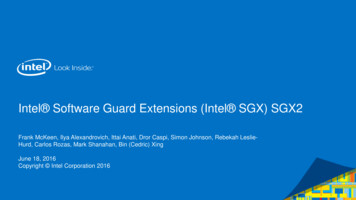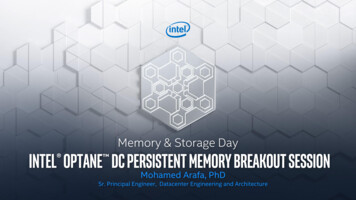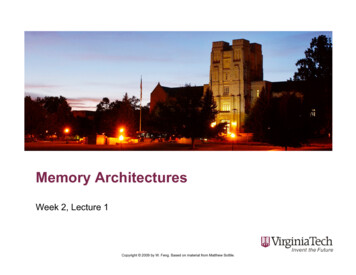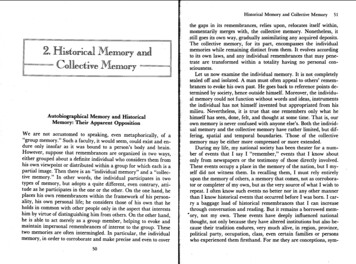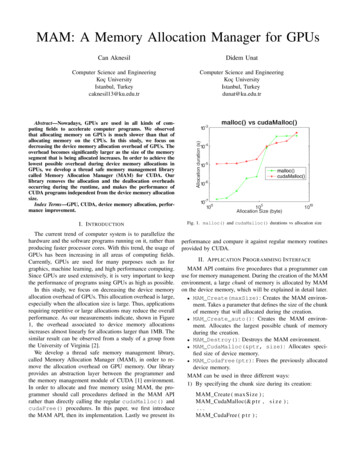
Transcription
MAM: A Memory Allocation Manager for GPUsCan AknesilDidem UnatComputer Science and EngineeringKoç UniversityIstanbul, Turkeycaknesil13@ku.edu.trComputer Science and EngineeringKoç UniversityIstanbul, Turkeydunat@ku.edu.trAbstract—Nowadays, GPUs are used in all kinds of computing fields to accelerate computer programs. We observedthat allocating memory on GPUs is much slower than that ofallocating memory on the CPUs. In this study, we focus ondecreasing the device memory allocation overhead of GPUs. Theoverhead becomes significantly larger as the size of the memorysegment that is being allocated increases. In order to achieve thelowest possible overhead during device memory allocations inGPUs, we develop a thread safe memory management librarycalled Memory Allocation Manager (MAM) for CUDA. Ourlibrary removes the allocation and the deallocation overheadsoccurring during the runtime, and makes the performance ofCUDA programs independent from the device memory allocationsize.Index Terms—GPU, CUDA, device memory allocation, performance improvement.I. I NTRODUCTIONThe current trend of computer system is to parallelize thehardware and the software programs running on it, rather thanproducing faster processor cores. With this trend, the usage ofGPUs has been increasing in all areas of computing fields.Currently, GPUs are used for many purposes such as forgraphics, machine learning, and high performance computing.Since GPUs are used extensively, it is very important to keepthe performance of programs using GPUs as high as possible.In this study, we focus on decreasing the device memoryallocation overhead of GPUs. This allocation overhead is large,especially when the allocation size is large. Thus, applicationsrequiring repetitive or large allocations may reduce the overallperformance. As our measurements indicate, shown in Figure1, the overhead associated to device memory allocationsincreases almost linearly for allocations larger than 1MB. Thesimilar result can be observed from a study of a group fromthe University of Virginia [2].We develop a thread safe memory management library,called Memory Allocation Manager (MAM), in order to remove the allocation overhead on GPU memory. Our libraryprovides an abstraction layer between the programmer andthe memory management module of CUDA [1] environment.In order to allocate and free memory using MAM, the programmer should call procedures defined in the MAM APIrather than directly calling the regular cudaMalloc() andcudaFree() procedures. In this paper, we first introducethe MAM API, then its implementation. Lastly we present itsFig. 1. malloc() and cudaMalloc() durations vs allocation sizeperformance and compare it against regular memory routinesprovided by CUDA.II. A PPLICATION P ROGRAMMING I NTERFACEMAM API contains five procedures that a programmer canuse for memory management. During the creation of the MAMenvironment, a large chunk of memory is allocated by MAMon the device memory, which will be explained in detail later. MAM Create(maxSize): Creates the MAM environment. Takes a parameter that defines the size of the chunkof memory that will allocated during the creation. MAM Create auto(): Creates the MAM environment. Allocates the largest possible chunk of memoryduring the creation. MAM Destroy(): Destroys the MAM environment. MAM CudaMalloc(&ptr, size): Allocates specified size of device memory. MAM CudaFree(ptr): Frees the previously allocateddevice memory.MAM can be used in three different ways:1) By specifying the chunk size during its creation:MAM Create ( maxSize ) ;MAM CudaMalloc(& p t r , s i z e ) ;.MAM CudaFree ( p t r ) ;
MAM Destroy ( ) ;2) Without specifying the size of the chunk during itscreation: In this case, the largest possible size is used.The largest possible size is allocated by performing multiple allocation operations by decreasing the allocationsize exponentially starting from the size of the devicememory until one of the allocations succeeds. We takethis approach because it is not possible to allocate entiredevice memory.MAMMAM.MAMMAMCreate auto ( ) ;CudaMalloc(& p t r , s i z e ) ;CudaFree ( p t r ) ;Destroy ( ) ;3) Without explicit creation: In this case lazy creationoccurs. MAM Create auto() is called automaticallywhen MAM CudaMalloc() is first called. When allthe memory allocated using MAM API is freed, MAMautomatically destroys itself.MAM CudaMalloc(& p t r , s i z e ) ;.MAM CudaFree ( p t r ) ;III. I MPLEMENTATIONDuring the creation of MAM, a large and continuous chunkof memory is allocated on the device memory. The size of thechunk is expected to be equal or smaller than the maximumsize of the device memory that will be used by the CUDAprogram at a time instance. The pointers to the segments of thislarge chunk of memory will be returned by MAM during theallocation process. Every object existing in MAM environmentother than the chunk live in the host memory.A chunk is divided into segments that are either beingused or not being used (empty) by the programmer. Figure 2represents an example of the chunk at a time instance. Theexample chunk is a continuous memory and consists of 5segments.In the MAM environment, each segment is representedby a segment struct instance in the host memory.The segment struct contains mainly, a pointer to thebeginning of the physical segment located in the devicememory, a size attribute, and a flag indicating whether it isbeing used by the program or not. The segment structdeclaration is as follows:s t r u c t segment {void b a s e P t r ;size t size ;char i s E m p t y ;/ a t t r i b u t e s r e l a t e d to datastructures /.};A. Internal Data StructuresIn MAM, there are two data structures that store thesegment struct instances. The first data structure is atree that stores all the segments. It is sorted according to thebase pointer of each segment that points to the beginningof the represented physical memory. It is used when theprogrammer calls MAM CudaFree(*void) in order to findthe corresponding segment using the pointer parameter.The second data structure is a tree-dictionary that storesonly the empty segments and it is sorted according to theirsize attribute. It is used to find an empty segment at an equalor greater size than the desired allocation size during theMAM CudaMalloc(**void, size t) call. In both datastructures, a red-black tree is used since it is a balanced tree.Fig. 3. Pointer treeFig. 2. An example of the chunkFigure 3 and Figure 4 show the corresponding data structures for the example chunk shown in Figure 2. At thatinstance, there are 3 segments that are allocated by the user(Segment 0, 2, and 3), and 2 segments that are not (Segment
Fig. 4. Size tree-dictionary1, and 4). Figure 3 shows the time instance of the pointertree. It contains all the segments and it is sorted by the basepointers of each segment. Figure 4 shows the time instance ofthe size-tree dictionary that contains all the empty segments.It is sorted according to the sizes of each segments.IV. M EMORY M ANAGEMENTAllocation and deallocation calls to MAM API respectivelystarts and ends the usage of segments located in the chunk,which was previously allocated. Since the total physical memory that will be used is allocated as a large chunk duringthe creation of MAM environment, MAM CudaMalloc()and MAM CudaFree() calls do not actually allocate or freeany physical memory but imitate the process. This is themain reason why MAM introduces much less overhead thanthe CUDA memory management module. The initializationof the MAM environment is slow but the initialization isperformed once at the beginning; once MAM is created, allthe memory management calls are faster. Next, we will discussthe allocation and deallocation implementations in MAM.Fig. 5. Allocation diagram 1Algorithm 1 MAM Allocation Algorithm - O(log n)1: procedure A LLOCATE2:Find a best-fitting empty segment from the treedictionary O(log n)3:Mark the segment as filled O(1)4:if The segment perfectly fits O(1) then5:Remove segment from tree-dictionary O(log n)6:else7:Resize it O(1)8:Remove it from tree-dictionary O(log n)9:Create a new empty segment O(1)10:Insert it in pointer-tree & tree-dictionary O(log n)11:end if12:Return the base pointer of filled segment O(1)13: end procedurein Figure 5 and Figure 6. In Figure 6, Segment 3 is a newlycreated segment.The algorithm of MAM allocation is shown in Algorithm 1.The complexities of all steps in the algorithm is shown at theend of each step. The overall complexity of this allocationalgorithm is O(log n), where n is the number of segmentsexisting in the chunk.B. DeallocationWhen the programmer calls MAM CudaFree(), MAMfirst marks the segment that is being freed as empty. Thenmerges the empty segment with previous and next segmentsif they are also empty. This procedure is illustrated in Figure7.The algorithm of MAM deallocation is shown in Algorithm 2. The overall completely of the deallocation algorithmis also O(log n), where n is the number of the segments inthe chunk.Fig. 6. Allocation diagram 2A. AllocationWhen the programmer calls MAM CudaMalloc(), MAMsearches the smallest empty segment whose size is equal orgreater than the desired segment using the size tree-dictionary.If there is an empty segment with the same size, MAMmarks it as filled. If the segment that is found is larger thenthe desired segment, a new segment that represents the nonallocated empty part is created. This procedure is illustratedFig. 7. Deallocation diagramThe allocation and deallocation algorithms are used in theimplementation of MAM API, respectively in the proceduresMAM CudaMalloc() and MAM CudaFree(). Thus, the
Algorithm 2 MAM Deallocation Algorithm - O(log n)1: procedure D EALLOCATE2:Find the segment in the pointer-tree O(log n)3:Mark the segment as empty O(1)4:Get previous and next segments O(log n)5:if the previous segment is empty O(1) then6:Remove the segment being newly emptied frompointer-tree and tree-dictionary O(log n)7:Destroy the segment being newly emptied O(1)8:Resize previous segment O(1)9:Replace it in tree-dictionary O(log n)10:Assign it to the variable stored the destroyedsegment O(log n)11:end if12://repeat the similar procedure for next segment.13: end procedureFig. 9. cudaFree() vs MAM CudaFree() comparisoncomplexities of both allocation and deallocation are O(log n)in terms of the number of segments.V. P ERFORMANCE E VALUATIONWe demonstrate the performance of MAM in two ways: interms of the allocation size, and in terms of the number ofpreviously allocated segments. We used Tesla K20m as theGPU testbed, Linux 2.6.32-431.11.2.el6.x86 64 as the kerneland NVCC 7.0, V7.0.27 as CUDA Compilation Tools in allof our tests.In order to measure the performance in terms of allocationsize, we created a histogram that stores the time elapsedduring allocation for different allocation sizes from 1Byte to1GigaByte. We filled the histogram by allocating the devicememory parts of random sizes over and over again until thereis no more space.Figure 8 and Figure 9 show the performance comparison between regular cudaMalloc() and MAM CudaMalloc(),and cudaFree() and MAM CudaFree(), respectively, interms of allocation size.Fig. 8. cudaMalloc() vs MAM CudaMalloc() comparisonAs shown in these figures, while allocation durationof cudaMalloc() increases swiftly, the duration ofMAM CudaMalloc() stays almost constant. MAM removesthe allocation and deallocation overhead and makes the performance of allocations independent from the allocation size.This result was expected because MAM moves the entirephysical memory allocation overhead to the creation of MAMenvironment from individual allocations. Even though theinitialization of MAM is slow, once it is initialized, thereis no significant overhead caused by memory allocations ordeallocations. Because, there is no physical memory allocationafter the creation of MAM and the allocation size has no effecton the complexity of MAM.The second performance measurement is based on the totalnumber of existing segments during allocation or deallocation.This is meaningful because the size of data structures usedin the MAM environment increases with the number ofsegments. In order to measure the performance in terms ofthe number of previously allocated segments, we measured thetime elapsed during the first allocation after allocated variablenumber of segments. In this measurement, the allocation sizewas random between 1Byte to 10Bytes, sufficiently small sothat we could make large number of allocations up to 107before the device memory is full. Figure 10 shows the performance comparison between regular cudaMalloc() andMAM CudaMalloc() in terms of the number of previouslyallocated segments.According to this performance measurement, MAM is fasterthan CUDA and the duration of MAM allocation increasesmore slowly than actual CUDA allocation for the numberof previously allocated segments larger than 100. This isthe result of the fact that allocation algorithm of MAM isO(log n), since the red-black tree used in MAM environmentis a balanced tree.We should also mention that when the programmer makesa very large number of small device memory allocations,
for CUDA. This library abstracts the CUDA memory management module from the program and succeeds to remove theoverhead by moving all the overhead to the beginning of theprogram. MAM currently offers a solution for the memoryallocation problem of CUDA but it can be easily extendedto be used in other platforms. Our future work will extendthis work to Intel Xeon Phi architectures and other GPUprogramming models.R EFERENCESFig. 10. cudaMalloc() vs MAM CudaMalloc() comparison accordingto number of previous allocationsMAM uses lots of host memory, since a segment structinstance is created for each segment.VI. D ISCUSSION & R ELATED W ORKThis study only covers the performance comparison ofMAM with CUDA device memory management. However,MAM is completely applicable to any other environment thatinvolves allocation and deallocation of a contiguous space ofany kind, such as pinned memory allocation of CUDA [7] orhost memory allocation. MAM will work exactly the same waywith any of these environments since it does not depend onthe actual, or physical allocation procedure once it is created.In the literature, there is a group that also focusses onGPU memory alloation and deallocation overhead [10]. Theycompare current GPU memory allocators and propse a newone that is register efficient. There are a lot of studies [7],[9], [8] about GPU memory management, mainly focusingon reducing data transfer overhead between the host anddevice memory. A study deals with the effective usage ofrelatively small GPU memory by using it as a cache for thehost memory and transferring data between the two memoriesduring runtime [3]. A second study that also focuses on smalldevice memory size decreases data transfer overhead betweendevice and host memory by directly connecting a Solid StateDisk (SSD) to a GPU [4]. A group has developed a tool tomanage device memory so that multiple applications can usethe GPU without any problems [5]. Another study integratedGPU as a first-class resource to the operating system [6].To our knowledge, there is no study focusing specificallyon solving GPU memory allocation overhead. Programmersgenerally write their own memory manager for their specificapplication when it is needed. MAM offers a generalizedsolution, is independent of an applications, and providesefficient data structures to keep the overhead low.VII. C ONCLUSIONIn this study, we focused on reducing the memory allocationoverhead in GPUs and we developed MAM, which is a library[1] ”CUDA Toolkit”, NVIDIA Developer, 2017. [Online]. t. [Accessed: 10- Jul- 2017].[2] CUDA Memory Management Overhead. [Online]. Available:https://www.cs.virginia.edu/ mwb7w/cuda support/memory management overhead.html.[Accessed: 14-Oct-2016].[3] Y. Kim, J. Lee, and J. Kim, ”GPUdmm: A high-performance and memoryoblivious GPU architecture using dynamic memory management,” inProc. IEEE Int. Symp. High Perform. Comput. Archit. (HPCA), Feb.2014, pp. 546-557.[4] J. Zhang, D. Donofrio, J. Shalf, M. Kandemir, and M. Jung. Nvmmu:A non-volatile memory management unit for heterogeneous gpu-ssdarchitectures. PACT 2015, 2015.[5] K. Wang, X. Ding, R. Lee, S. Kato, and X. Zhang, ”Gdm: Devicememory management for gpgpu computing,” in The 2014 ACM International Conference on Measurement and Modeling of Computer Systems,SIGMETRICS, (New York, NY, USA), pp. 533-545, ACM, 2014.[6] S. Kato, M. McThrow, C. Maltzahn, and S. A. Brandt. Gdev: First-classgpu resource management in the operating system. In USENIX AnnualTechnical Conference, 2012.[7] B. Bastem, D. Unat, W. Zhang, A. Almgren, and J. Shalf. OverlappingData Transfers with Computation on GPU with Tiles, The 46th International Conference on Parallel Processing, ICPP 2017[8] Mehmet E. Belviranli, Farzad Khorasani, Laxmi N. Bhuyan, and RajivGupta. 2016. CuMAS: Data Transfer Aware Multi-Application Scheduling for Shared GPUs. In Proceedings of the 2016 International Conferenceon Supercomputing (ICS ’16). ACM, New York, NY, USA, Article 31,12 pages.[9] T. Gysi, J. Bar and T. Hoefler, dCUDA: Hardware Supported Overlapof Computation and Communication, SC16: International Conference forHigh Performance Computing, Networking, Storage and Analysis, SaltLake City, UT, 2016, pp. 609-620.[10] M. Vinkler and V. Havran, ”Register Efficient Dynamic Memory Allocator for GPUs”, Computer Graphics Forum, vol. 34, no. 8, pp. 143-154,2015.
We develop a thread safe memory management library, called Memory Allocation Manager (MAM), in order to re-move the allocation overhead on GPU memory. Our library provides an abstraction layer between the programmer and the memory management module of CUDA [1] environment. In order to allocate and free memory using MAM, the pro-



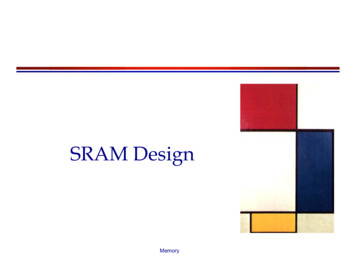
![[Title to come] DSP Dynamic Asset Allocation Fund](/img/24/dsp-dynamic-asset-allocation-fund.jpg)
